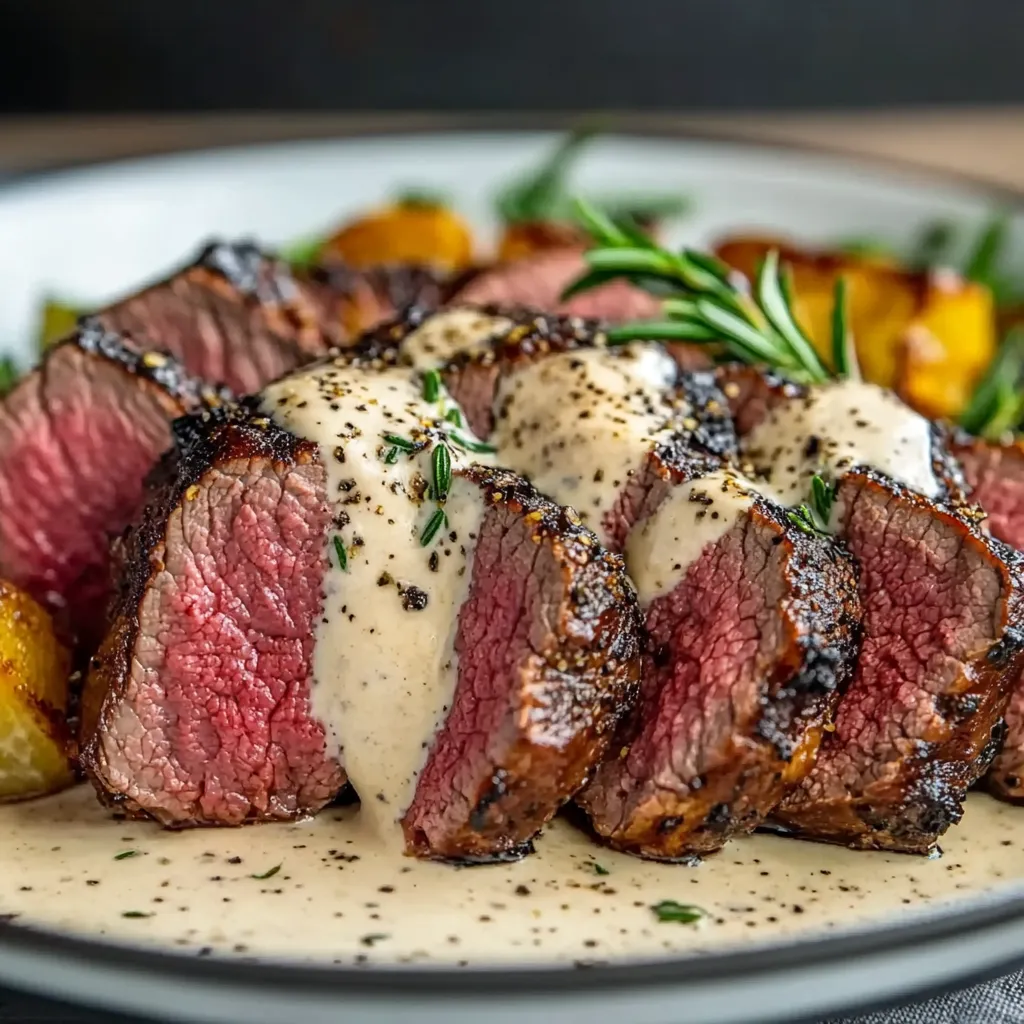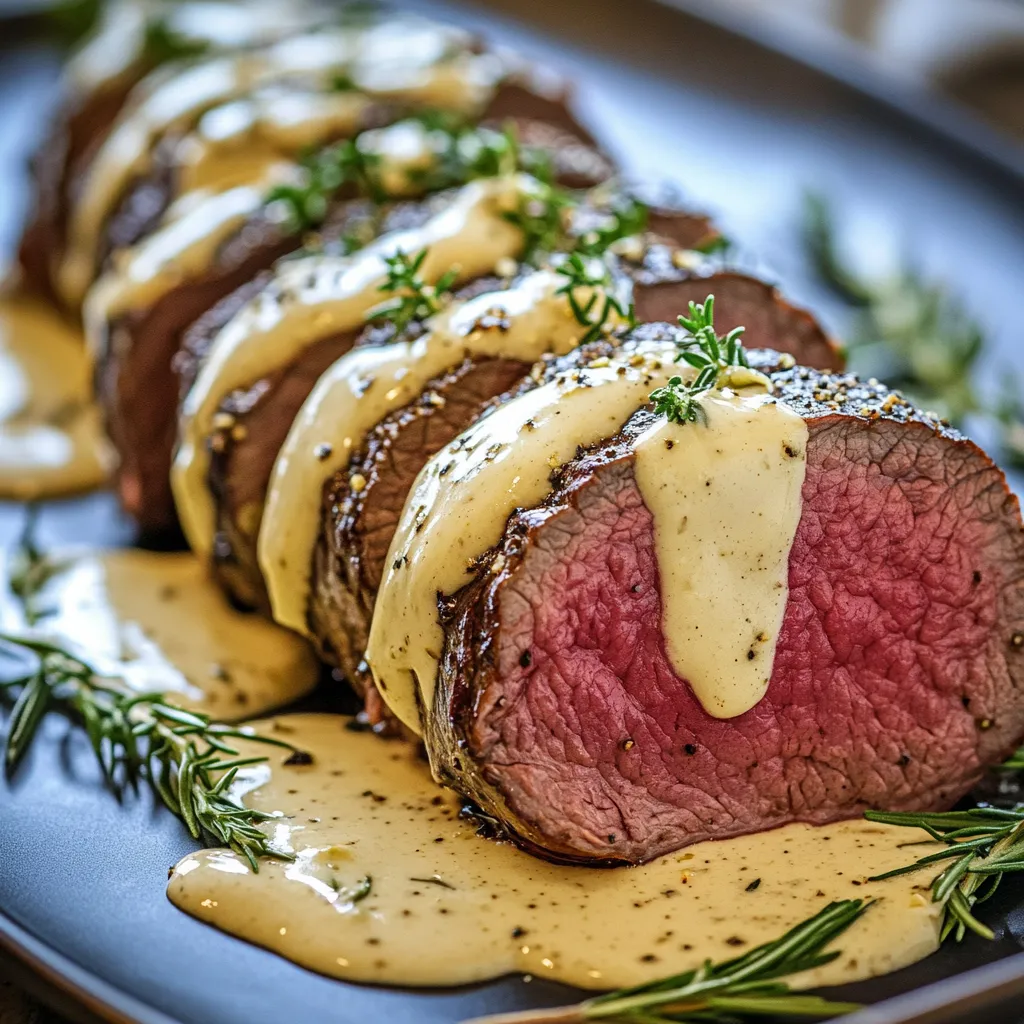 Bookmark
Bookmark
This tender beef tenderloin roast transforms your dinner table into a restaurant-worthy experience with minimal effort. The perfectly seared crust and butter herb coating create a melt-in-your-mouth texture while the optional horseradish adds just the right kick for those who appreciate subtle heat.
I first made this tenderloin for my husband's birthday when our reservation fell through, and it has since become our celebration go to dish. The look on his face when he took that first bite convinced me home cooking could rival any steakhouse experience.
Ingredients
- Beef tenderloin trimmed and tied provides the foundation for this elegant dish. Select a piece with good marbling and a bright red color for the best flavor.
- Salt and black pepper seem simple but are crucial for developing that perfect crust during searing.
- Olive oil helps achieve the initial sear without burning the exterior of your precious beef.
- Salted butter creates that luxurious mouth feel and carries the herbs and garlic throughout the meat as it melts.
- Garlic minced fresh delivers aromatic notes that complement beef perfectly without overpowering.
- Prepared horseradish or Dijon mustard adds a subtle kick that cuts through the richness of the meat.
- Rosemary or thyme fresh herbs elevate this dish from good to extraordinary with their aromatic qualities.
Step-by-Step Instructions
- Prepare the Beef
- Allow your tenderloin to sit at room temperature for about 2 hours before cooking. This crucial step ensures even cooking from edge to center. The meat should feel cool but not cold to the touch before proceeding. Season generously with salt and pepper, pressing the seasonings into all surfaces of the meat.
- Create the Perfect Sear
- Heat your cast iron skillet until it just starts to smoke before adding the oil. When searing, resist the urge to move the meat prematurely. It will naturally release from the pan when a proper crust has formed, usually after 3 4 minutes per side. Listen for that satisfying sizzle which tells you the temperature is perfect.
- Butter Mixture Magic
- The compound butter should be very soft but not melted when you mix in the aromatics. Take your time to ensure everything is evenly incorporated, mashing with a fork against the sides of the bowl to release the essential oils from the herbs and garlic. This creates an aromatic paste that will baste your meat as it roasts.
- Temperature Monitoring
- Insert your thermometer at an angle into the thickest part of the meat, avoiding touching the pan. For rare, aim for 120 125°F, medium rare 130 135°F, medium 140 145°F. Remember the temperature will rise another 5 degrees during resting, so remove the roast just before it reaches your target.
- The Essential Rest
- After removing from the oven, tent the tenderloin loosely with foil and allow it to rest undisturbed. This resting period allows the juices to redistribute throughout the meat. Cut too soon, and those precious juices will pool on your cutting board instead of remaining in each slice.
 Bookmark
Bookmark
The first time I served this tenderloin at a family gathering, my brother in law who rarely comments on food asked for the recipe. What makes this special is the contrast between the caramelized exterior and the buttery tender interior that simply cannot be achieved with other cuts of beef.
The Perfect Temperature Guide
Understanding doneness is crucial when preparing beef tenderloin. A good meat thermometer is your best friend here. For rare beef, aim for 120 125°F internal temperature. Medium rare, which many chefs consider ideal for tenderloin, registers at 130 135°F. Medium comes in at 140 145°F, while medium well reaches 150 155°F. Remember that during the resting period, your meat will continue cooking slightly, increasing in temperature by approximately 5 degrees. This carryover cooking means you should remove your tenderloin from the heat when it registers about 5 degrees below your target temperature.
Serving Suggestions
While this tenderloin stands beautifully on its own, thoughtful accompaniments elevate the experience. Creamy mashed potatoes make an ideal base, soaking up any meat juices. Roasted asparagus or green beans provide color and textural contrast. For a complete presentation, consider a red wine reduction sauce made from the pan drippings. Simply deglaze the hot pan with a cup of dry red wine after removing the tenderloin, add a cup of beef stock, and reduce by half before whisking in a tablespoon of cold butter. Slice the tenderloin into medallions approximately 1 inch thick and arrange them slightly overlapping on a warmed platter for an impressive presentation.
Make Ahead Options
You can prepare components of this dish in advance for stress free entertaining. The compound butter can be made up to three days ahead and refrigerated. Simply bring it to room temperature before using. The beef can be seasoned and tied up to 24 hours ahead, kept covered in the refrigerator. Just remember to bring it to room temperature for about two hours before cooking. If you want to prepare the entire dish ahead of time, consider undercooking the tenderloin slightly, as it will continue cooking when reheated. Cool completely, wrap tightly, and refrigerate. To serve, bring to room temperature for an hour, then warm in a 300°F oven until it reaches your desired internal temperature.
Recipe FAQs
- → What internal temperature should I cook the beef tenderloin to?
For rare beef tenderloin, aim for 125°F (52°C). For medium-rare, cook to 135°F (57°C). Medium doneness is 145°F (63°C). Remember that the temperature will rise about 5°F during resting, so remove the tenderloin from the oven when it's 5 degrees below your target temperature.
- → Why do I need to tie the beef tenderloin?
Tying the tenderloin with butcher's twine creates a uniform shape that promotes even cooking throughout the roast. This helps prevent the thinner ends from overcooking before the center reaches your desired doneness, resulting in more consistent results.
- → Can I prepare the tenderloin in advance?
You can season the tenderloin up to 24 hours in advance and keep it refrigerated. The herb-butter mixture can also be prepared ahead and refrigerated. Just bring the meat to room temperature for about 2 hours before cooking, and soften the butter mixture before applying.
- → What can I substitute for horseradish in the butter mixture?
Dijon mustard makes an excellent substitute for horseradish in the butter mixture as mentioned in the ingredients. You could also use whole grain mustard or a small amount of wasabi paste for a different but complementary flavor profile.
- → How do I make the creamy horseradish sauce?
For a simple creamy horseradish sauce, combine 1/2 cup sour cream, 2 tablespoons prepared horseradish, 1 tablespoon Dijon mustard, 1 teaspoon white wine vinegar, salt, and pepper to taste. For a richer version, add 2 tablespoons mayonnaise and 1 tablespoon chopped chives.
- → Why should I let the meat rest before slicing?
Resting for 10-15 minutes allows the juices to redistribute throughout the meat. If you slice immediately after cooking, these flavorful juices will run out onto the cutting board instead of remaining in the meat, resulting in drier, less flavorful beef.
